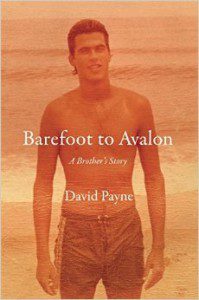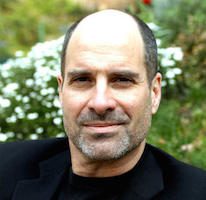
David Payne’s memoir Barefoot To Avalon begins with a difficult question: In what way, if any, could Payne have prevented his brother George’s tragic death? Readers who have lost a loved one too early have asked themselves the same.
We start on the day of the accident that took his brother’s life. George had arrived to help Payne move from Vermont to North Carolina, where Payne would rejoin his wife during a rocky part of their doomed marriage. After a clear exploration of those hours, we go back to several beginnings.
David Payne started out as a smart young boy from a prominent white North Carolina family in an insular small town. He was sent away to prep school at Exeter. The weekend he was being dropped off at school, he witnessed an assault no boy should have ever seen. Later, he had to endure his parent’s ugly divorce, his father’s humiliation and exit. To his mother’s abrupt second marriage, he reacted with a Hamlet-worthy escapade. If his family’s turmoil were not enough, his time in liberal New England during the late sixties alienated him from his Southern roots. He couldn’t take the strict route that upper middle class white boys were expected to take: success in athletics, followed by a career in law or business, fatherhood, prominent “citizenship.” He should have become a character from a story by Peter Taylor, not by Jack Kerouac, somebody who loved golf and hunting, not poetry, psychology, art. He didn’t comply. He couldn’t, given who he was, what he’d seen, given his role in the family constellation.
His younger brother George stayed closer to home, and, for a time, was the favored son. The book includes a lovely scene when the two meet accidentally on campus at Chapel Hill: the author is word drunk, bare-footed, long-haired after a semester away from school, finding himself by starving at a beach house writing poetry. He walks down along fraternity row in frayed jean cutoffs on a fall evening and sees a handsome, six-foot six fellow among the DKE revelers, a pale yellow cashmere sweater casually tied around his neck. To his surprise it’s his brother, new to the school and in many ways a complete stranger.
Mr. Payne’s description of his youth is perhaps of the best writing in the book. He is daring, needy, aggressive, and vulnerable—contradictory. Obsessed with Jung and Latin, a would–be mystic who would doesn’t eat meat, he still hopes his estranged daddy will give him the gun he was promised. He still wants to be taken hunting. Meanwhile his younger brother marries the sorority girl, buys the center-hall Georgian, becomes a junior Southern patrician in the Reagan era, drives the BMW.

One day at work George goes into the bathroom, strips, shreds his credit cards, and announces he’s been “tapped for a mission” in Tehran. Hauled off to the mental ward, he is diagnosed with bipolar I disorder with psychotic features.
In retrospect, his conformity could have been a desperate defense against interior chaos. The author and his mother do what they can to help George A. stabilize, but the prognosis is poor.
About the same time, Payne pulled ahead, spectacularly: his first novel, Confessions of a Taoist on Wall Street, was a sensation. In a more gentlemanly age, he might have enjoyed absolute loyalty from an editor for an entire career. But the publishing business of the eighties and nineties was in a turmoil of its own. He met with challenges in his writing career, marriage, fatherhood, and eventually—or perhaps inevitably—with keeping sober.
The brothers were quite distant by the time of the tragedy. We hear about their rivalry, their hurts and mutual distrust, which Payne vividly renders in flashback scenes. David disapproved of his brother’s retreat to total dependency. He thought his brother ought to “try” instead of spending all day smoking cigarettes, watching TV in his mother’s house.
Packing up David’s house in Vermont, and sharing a drive down to North Carolina with U-Hauls, gave them hope of spanning that distance. Too little too late: George died on the road back South when the rented truck fishtailed and he lost control.
The heart of Payne’s memoir is the great gap between these two brothers, and David’s struggles before and after George’s death. We see their efforts to be good men, to make their way in the world as wounded and damaged as they are. They never get it quite right. Payne forces himself to show us the worst and the best. Merging memoir with tragedy, he shows us not only what it was, but what could never be.
Payne’s unique contribution to the genre of memoir could be his comprehensiveness. There’s something critic Fred Hobson calls “the Southern urge to explain,” apparent in last-century works by Faulkner or Penn Warren or Thomas Wolfe. Payne brings the same impulse into a new mode. With a distinctly Southern ambition, he insists that every tangent be traced back to the center, to the “spots of time” he’s exploring and exploding. In this, Barefoot to Avalon stands apart from the more linear heroes and heroines who populate today’s memoirs. Barefoot to Avalon insists that individual history and old harm imbue every hour of our lives, and that every hour is also entirely new, unlived, full of potential.




